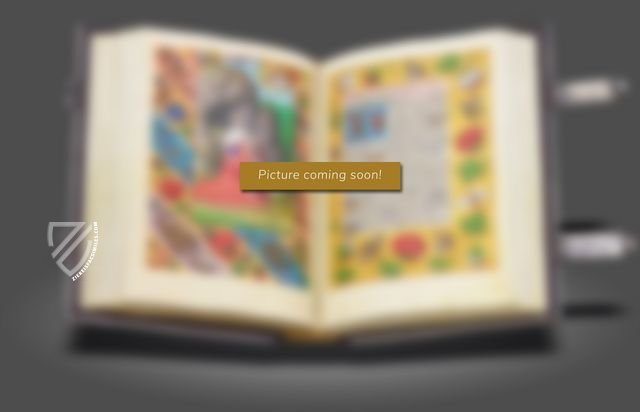Works of Geoffrey Chaucer
(under 1,000€)
William Morris was a 19th-century designer, social reformer, and writer who shared a love of Geoffrey Chaucer’s works with the celebrated Victorian painter Edward Burne-Jones. The lifelong friends and alumni from Oxford University spent years creating The Works of Geoffrey Chaucer in the style of a medieval manuscript, particularly with regard to its rich floral borders. Published in 1896, this project was the magnum opus of the Kelmscott Press and as such it is sometimes referred to as the “Kelmscott Chaucer”. Burne-Jones created 87 woodcuts for the work, which were engraved by William Harcourt Hooper. The codex is remarkable for its beauty and detail; it set new standards of book design at the end of the 19th century and was referred to by Burne-Jones as a “pocket cathedral”.
Works of Geoffrey Chaucer
One of the last and most magnificent testimonials to the popularity of medievalism is the so-called “Kelmscott Chaucer”, which is the result of a painstaking collaboration between inter alia William Morris (1834–96), Sir Edward Burne-Jones (1833–98), and William Harcourt Hooper (1834–1912). Published in 1896 after four years of painstaking work, The Works of Geoffrey Chaucer now newly imprinted was an instant success that was showered with praise by the public, press, and even notable literary figures like William Butler Yeats (1865–1939) who called it “the most beautiful of all printed books”. This splendid work was the last great project undertaken by Morris, founder of the Kelmscott Press who had studied incunabula – a term for early printed books predating 1501 from the Latin word for “cradle”. His friend and chief collaborator Burnes-Jones who wrote “If we live to finish it, it will be like a pocket cathedral – so full of design and I think Morris the greatest master of ornament in the world.”
The Kelmscott Press
Disappointed by the declining quality of printed books, William Morris sought to revive the art of hand printing as it had been practiced during the 15th century by founding a traditional printing house. Although the Kelmscott Press only existed between the years 1891 and 1898, it produced 53 books in 66 volumes of exceptional quality that were limited editions typically of 300 or so copies that had an immediate and lasting impact on fine book printing both in Britain and abroad. Morris accomplished this by taking an unflinchingly fundamentalist approach: he recreated historic dyes from traditional recipes, used only handmade paper, and only employed the German firm of Jaenecke to make ink after he failed to create his own of a satisfactory quality. Morris named the printing house after Kelmscott Manor – his beloved 16th century limestone country home in Wiltshire whose unspoiled rustic charm inspired him in part to establish the Kelmscott Press and become a master printer.
A Truly Luxurious Printed Book
Sir Edward Burne-Jones was a celebrated Victorian painter who created 87 woodcut illustrations that were the engraved by William Harcourt Hooper. The work is additionally adorned by a woodcut title page, 14 large borders for text, 18 frames for illustrations, and 26 large initials, some historiated*, created by William Morris. The original run of 325 copies on paper was expanded to 425, which were sold for **£20 each, an additional 13 copies were printed on vellum for the princely sum of £126, and 48 copies were given a special white pigskin binding with silver clasps. Critics claimed that the Kelmscott Press only produced luxury items for the rich, which contrasted with the socialist principles Morris held dear. However, Morrison would argue that he created the Kelmscott Press as a rejection of the shoddy quality of mass-produced goods created by the industrial system that had destroyed the livelihoods of traditional craftsmen and an attempt to revive these arts.
Codicology
- Alternative Titles
- Kelmscott Chaucer
Arbeiten von Geoffrey Chaucer
St. John's College, Cambridge, Manuscript L.1 - Size / Format
- 262 pages / 23.5 × 15.0 cm
- Origin
- United Kingdom
- Date
- Second quarter of the 15th century
- Epochs
- Style
- Genre
- Language
- Script
- Anglicana Formata
- Artist / School
- Geoffrey Chaucer (ca. 1340s–1400) (author)
Edward Burne-Jones (1833–98) (woodcuts)
William Morris (1834–96) (author)
#1 St. John's College, Cambridge, Manuscript L.1: a facsimile
Language: English
(under 1,000€)
- Treatises / Secular Books
- Apocalypses / Beatus
- Astronomy / Astrology
- Bestiaries
- Bibles / Gospels
- Chronicles / History / Law
- Geography / Maps
- Saints' Lives
- Islam / Oriental
- Judaism / Hebrew
- Single Leaf Collections
- Leonardo da Vinci
- Literature / Poetry
- Liturgical Manuscripts
- Medicine / Botany / Alchemy
- Music
- Mythology / Prophecies
- Psalters
- Other Religious Books
- Games / Hunting
- Private Devotion Books
- Other Genres
- Afghanistan
- Armenia
- Austria
- Belgium
- Colombia
- Croatia
- Cyprus
- Czech Republic
- Denmark
- Egypt
- Ethiopia
- France
- Germany
- Greece
- Hungary
- India
- Iran
- Iraq
- Israel
- Italy
- Japan
- Lebanon
- Luxembourg
- Mexico
- Morocco
- Netherlands
- Palestine
- Peru
- Poland
- Portugal
- Russia
- Serbia
- Spain
- Sri Lanka
- Sweden
- Switzerland
- Syria
- Turkey
- Ukraine
- United Kingdom
- United States
- Uzbekistan
- Aboca Museum
- Ajuntament de Valencia
- Akademie Verlag
- Akademische Druck- u. Verlagsanstalt (ADEVA)
- Aldo Ausilio Editore - Bottega d’Erasmo
- Alecto Historical Editions
- Alkuin Verlag
- Almqvist & Wiksell
- Amilcare Pizzi
- Andreas & Andreas Verlagsbuchhandlung
- Archa 90
- Archiv Verlag
- Archivi Edizioni
- Arnold Verlag
- ARS
- Ars Magna
- ArtCodex
- AyN Ediciones
- Azimuth Editions
- Badenia Verlag
- Bärenreiter-Verlag
- Belser Verlag
- Belser Verlag / WK Wertkontor
- Benziger Verlag
- Bernardinum Wydawnictwo
- BiblioGemma
- Biblioteca Apostolica Vaticana (Vaticanstadt, Vaticanstadt)
- Bibliotheca Palatina Faksimile Verlag
- Bibliotheca Rara
- Boydell & Brewer
- Bramante Edizioni
- Bredius Genootschap
- Brepols Publishers
- British Library
- C. Weckesser
- Caixa Catalunya
- Canesi
- CAPSA, Ars Scriptoria
- Caratzas Brothers, Publishers
- Carus Verlag
- Casamassima Libri
- Chavane Verlag
- Christian Brandstätter Verlag
- Circulo Cientifico
- Club Bibliófilo Versol
- Club du Livre
- CM Editores
- Collegium Graphicum
- Collezione Apocrifa Da Vinci
- Comissão Nacional para as Comemorações dos Descobrimentos Portugueses
- Coron Verlag
- Corvina
- CTHS
- D. S. Brewer
- Damon
- De Agostini/UTET
- De Nederlandsche Boekhandel
- De Schutter
- Deuschle & Stemmle
- Deutscher Verlag für Kunstwissenschaft
- DIAMM
- Droz
- E. Schreiber Graphische Kunstanstalten
- Ediciones Boreal
- Ediciones Grial
- Ediclube
- Edições Inapa
- Edilan
- Editalia
- Edition Deuschle
- Edition Georg Popp
- Edition Leipzig
- Edition Libri Illustri
- Editiones Reales Sitios S. L.
- Éditions de l'Oiseau Lyre
- Editions Medicina Rara
- Editorial Casariego
- Editorial Mintzoa
- Editrice Antenore
- Editrice Velar
- Edizioni Edison
- Egeria, S.L.
- Eikon Editores
- Electa
- Emery Walker Limited
- Enciclopèdia Catalana
- Eos-Verlag
- Ephesus Publishing
- Ernst Battenberg
- Eugrammia Press
- Extraordinary Editions
- Fackelverlag
- Facsimila Art & Edition
- Facsimile Editions Ltd.
- Facsimilia Art & Edition Ebert KG
- Faksimile Verlag
- Feuermann Verlag
- Folger Shakespeare Library
- Franco Cosimo Panini Editore
- Friedrich Wittig Verlag
- Fundación Hullera Vasco-Leonesa
- G. Braziller
- Gabriele Mazzotta Editore
- Gebr. Mann Verlag
- Gesellschaft für graphische Industrie
- Getty Research Institute
- Giovanni Domenico de Rossi
- Giunti Editore
- Graffiti
- Grafica European Center of Fine Arts
- Guido Pressler
- Guillermo Blazquez
- Gustav Kiepenheuer
- H. N. Abrams
- Harrassowitz
- Helikon
- Hendrickson Publishers
- Henning Oppermann
- Herder Verlag
- Hes & De Graaf Publishers
- Hoepli
- Holbein-Verlag
- Hortus Deliciarum
- Houghton Library
- Hugo Schmidt Verlag
- Idion Verlag
- Il Bulino, edizioni d'arte
- ILte
- Imago
- Insel Verlag
- Instituto Nacional de Antropología e Historia
- Istituto dell'Enciclopedia Italiana - Treccani
- Istituto Ellenico di Studi Bizantini e Postbizantini
- Istituto Geografico De Agostini
- Istituto Poligrafico e Zecca dello Stato
- Italarte Art Establishments
- J. Thorbecke
- Jan Thorbecke Verlag
- Johnson Reprint Corporation
- Josef Stocker
- Josef Stocker-Schmid
- Jugoslavija
- Karl W. Hiersemann
- Kasper Straube
- Kaydeda Ediciones
- Kindler Verlag / Coron Verlag
- Kodansha International Ltd.
- Konrad Kölbl Verlag
- Kurt Wolff Verlag
- La Liberia dello Stato
- La Linea Editrice
- La Meta Editore
- Lambert Schneider
- Landeskreditbank Baden-Württemberg
- Leo S. Olschki
- Les Incunables
- Library of Congress
- Libreria Musicale Italiana
- Lichtdruck
- Lito Immagine Editore
- Lumen Artis
- Lund Humphries
- M. Moleiro Editor
- Maison des Sciences de l'homme et de la société de Poitiers
- Manuscriptum
- Martinus Nijhoff
- Maruzen-Yushodo Co. Ltd.
- MASA
- McGraw-Hill
- Militos
- Millennium Liber
- Müller & Schindler
- Nahar and Steimatzky
- National Library of Wales
- Neri Pozza
- Nova Charta
- Oceanum Verlag
- Odeon
- Orbis Mediaevalis
- Orbis Pictus
- Österreichische Staatsdruckerei
- Oxford University Press
- Pageant Books
- Parzellers Buchverlag
- Patrimonio Ediciones
- Pattloch Verlag
- PIAF
- Pieper Verlag
- Plon-Nourrit et cie
- Prestel Verlag
- Princeton University Press
- Prisma Verlag
- Priuli & Verlucca, editori
- Pro Sport Verlag
- Propyläen Verlag
- Pytheas Books
- Quaternio Verlag Luzern
- Reales Sitios
- Recht-Verlag
- Reichert Verlag
- Reichsdruckerei
- Riehn & Reusch
- Roberto Vattori Editore
- Rosenkilde and Bagger
- Roxburghe Club
- Salerno Editrice
- Sarajevo Svjetlost
- Schöck ArtPrint Kft.
- Scolar Press
- Scrinium
- Scripta Maneant
- Scriptorium
- Siloé, arte y bibliofilia
- SISMEL - Edizioni del Galluzzo
- Sociedad Mexicana de Antropología
- Société des Bibliophiles & Iconophiles de Belgique
- Soncin Publishing
- Sorli Ediciones
- Stainer and Bell
- Studer
- Styria Verlag
- Sumptibus Pragopress
- Szegedi Tudomànyegyetem
- Taberna Libraria
- Tarshish Books
- Taschen
- Tempus Libri
- Testimonio Compañía Editorial
- Thames and Hudson
- The Clear Vue Publishing Partnership Limited
- The Facsimile Codex
- The Folio Society
- The Marquess of Normanby
- The Richard III and Yorkist History Trust
- Tip.Le.Co
- TouchArt
- TREC Publishing House
- TRI Publishing Co.
- Trident Editore
- Typis Regiae Officinae Polygraphicae
- Union Verlag Berlin
- Universidad de Granada
- University of California Press
- University of Chicago Press
- Urs Graf
- Vallecchi
- Van Wijnen
- VCH, Acta Humaniora
- VDI Verlag
- VEB Deutscher Verlag für Musik
- Verlag Anton Pustet / Andreas Verlag
- Verlag Bibliophile Drucke Josef Stocker
- Verlag der Münchner Drucke
- Verlag für Regionalgeschichte
- Verlag Styria
- Vicent Garcia Editores
- W. Turnowsky
- Waanders Printers
- Wiener Mechitharisten-Congregation (Wien, Österreich)
- Wissenschaftliche Buchgesellschaft
- Wydawnictwo Dolnoslaskie
- Xuntanza Editorial
- Zakład Narodowy
- Zollikofer AG




